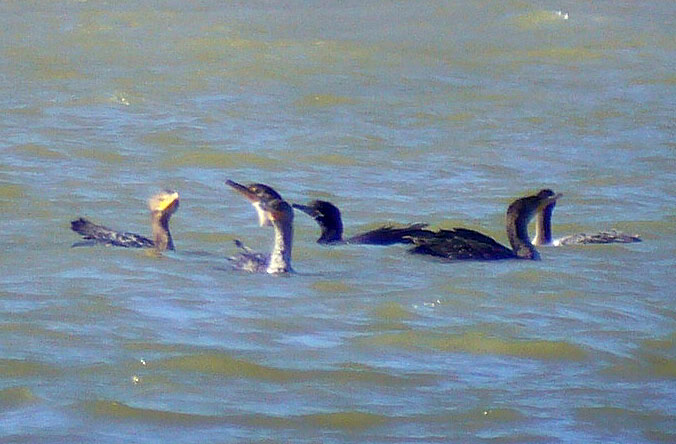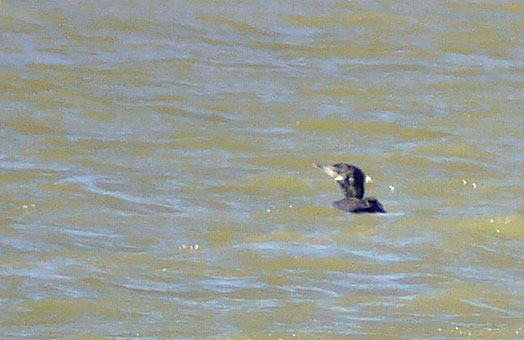Neotropic Cormorant (Phalacrocorax brasilianus)
Fig Lagoon, Seeley, Imperial County, CA
28 November 2010
Joseph Morlan
Photos © 28 November 2010 by Joseph Morlan. All rights reserved.
 Robbie
Fischer and I arrived about 1:00pm to look for Neotropic Cormorants at Fig Lagoon. One bird was first reported
by Guy McCaskie on 23 September and another found by Mark Billings on 11 November. Three birds reportedly seen
25 November; and a report of four the next day need substantiation. Two were present through January of last winter
and these are likely the same individuals returning.
Robbie
Fischer and I arrived about 1:00pm to look for Neotropic Cormorants at Fig Lagoon. One bird was first reported
by Guy McCaskie on 23 September and another found by Mark Billings on 11 November. Three birds reportedly seen
25 November; and a report of four the next day need substantiation. Two were present through January of last winter
and these are likely the same individuals returning.
We parked on the top of the cliff on the south side and scoped the snags across the way. The wind was very strong
and it was impossible to keep the scope sturdy outside the car, so I set the scope up inside the back seat. Eventually
I located two Neotropic Cormorants resting on snags along with numerous Double-crested Cormorants. I attempted
to disgiscope these distant birds, but the birds were too far and the scope too unstable. We drove around to the
low road on the north side of the lagoon, but when we arrived at the snag with the Neotropic Cormorants, all the
birds flew to the northwest end of the lagoon. Driving further, I eventually located a single Neotropic Cormorant
swimming and diving with Double-crested Cormorants and managed a few distant digiscoped images. In the image to
the right, one adult Neotropic Cormorant is visible in the middle. The camera was a Panasonic DMC-LZ5 hand-held
to a Nikon FieldScope 3 with 30X WA eyepiece.
Description
The following description is based on memory and on the photos.
All the birds were similar. At first I was able to pick out the distant perched Neotropic Cormorants by their
somewhat smaller size, but longer tail compared to the many Double-crested Cormorants. The key was the narrow gular
patch which from my distance did not show yellow, but did show a narrow crisp white border coming to a point just
behind the gape. Both were otherwise all black with a grayish bill, pale at the base, hooked at the tip and often
held angled up. When swimming the Neotropic Cormorant often held its long tail up out of the water, unlike the
Double-crested Cormorants. I only saw two birds together perched and it is possible that one of them was the same
individual seen later swimming. However, I understand that there may be three adult Neotropic Cormorants present
at Fig Lagoon and some observers have claimed as many as four.  I am satisfied to report that we saw at least two.
I am satisfied to report that we saw at least two.
Discussion
California has 21 previously accepted records. This species has been expanding its range into Arizona in recent
decades. Formerly accidental there, it is now regular in many localities and even outnumbers Double-crested Cormorants
in some places. Likewise it has increased in Southern California where all records come from the Imperial Valley
and along the Colorado River.
Additional Photo (external links)
Tom Bensen - 11 November (swimming).
Eric Kallen - 11
November (perched)
Robert McNab - 20 November (two birds perched).
I suspect these may be the same two birds we saw on the same snag.
 Robbie
Fischer and I arrived about 1:00pm to look for Neotropic Cormorants at Fig Lagoon. One bird was first reported
by Guy McCaskie on 23 September and another found by Mark Billings on 11 November. Three birds reportedly seen
25 November; and a report of four the next day need substantiation. Two were present through January of last winter
and these are likely the same individuals returning.
Robbie
Fischer and I arrived about 1:00pm to look for Neotropic Cormorants at Fig Lagoon. One bird was first reported
by Guy McCaskie on 23 September and another found by Mark Billings on 11 November. Three birds reportedly seen
25 November; and a report of four the next day need substantiation. Two were present through January of last winter
and these are likely the same individuals returning. I am satisfied to report that we saw at least two.
I am satisfied to report that we saw at least two.